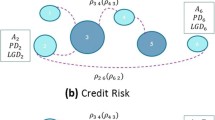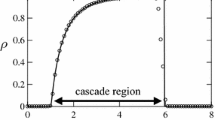Abstract
We propose a network-based structural model of credit risk to demonstrate how idiosyncratic and systemic shocks propagate across the banking system and evaluate the costs. The banking system is built as a network of heterogeneous banks which are connected with one another. In such a system, single credit events propagate through the interbank market from debtors to creditors and across the system. The shock is imposed as an unexpected event. We demonstrate that while idiosyncratic shocks cannot substantially disturb the banking system, a systemic shock of even a moderate magnitude can be highly detrimental. Such shock includes a huge contagious potential. We demonstrate that the costs of the shock are largely determined by the extent of contagion and range from negligible to catastrophic. The results imply that a severe crisis has to be initiated by a systemic shock of at least moderate magnitude. Capital ratio and the bank size are two additional factors of the banking system stability. Finally, credit risk analysis is sensitive to the network topology and exhibits a profound nonlinear characteristic.





Similar content being viewed by others
Notes
In recent history, the default of Russian government debt in August 1998 sunk Long-Term Capital Management (LTCM), while the collapse of the subprime housing market in 2007 sunk Bear Stearns, Merrill Lynch and Lehman Brothers and many others, and continued into a sovereign debt crisis in Europe. Systemic events may take various forms, such as economic downturn, fall in the housing prices or in sovereign debt etc. Kindleberger and Aliber (2011) and Reinhart and Rogoff (2009) provide a thorough historical overview of financial crises.
See Upper (2011) for the recent overview of the credit contagion literature.
We use the banks’ Tier 1 capital levels instead of equity because the banks’ solvency is determined upon the former and not the latter, although the bank equity is among the core constituents of its Tier 1 capital. Tier 1 capital ratio is also the most frequently monitored and observed parameter in the banking industry. In the sequel, we interchangeable use the words of capital and Tier 1 capital to refer to Tier 1 capital.
No loops or multiple links are allowed.
Eventual mutual exposures between the banks do not imply debt reconciliation.
On the contrary, highly positive correlation between default rates and the GDP growth and the negative correlation between default rates and RR have been observed (Shleifer and Vishny 1992; Altman et al. 2005; Acharya et al. 2007). Shleifer and Vishny (2011) provide a discussion on asset fire sales in the perspective of the latest financial crisis.
Iori et al. (2008), Schweitzer et al. (2009) and Allen and Babus (2009) argue that the network of major international financial institutions is strongly interdependent, exhibiting an increasing scale-free characteristic. Such networks are resilient to random failures, but susceptible to targeted attacks (Albert et al. 2000).
There was no specific rule according to which the single banks were selected. However, to reflect the structure of the banking system, we wanted to have a few big banks, some medium-sized banks and a majority of smaller banks. Banks come from the US, UK, Switzerland, Germany, the Netherlands, Italy, Belgium, Japan, Austria and Slovenia.
The real data on total assets and the Tier 1 capital is used to get a reflection of banks’ two the most important parameters. It should be emphasized that balance sheet structures from the paper do not reflect the actual balance sheets structures of corresponding banks, but are modified accordingly to meet the requirements of different network topologies and the banks’ initial data on total assets and the capital constraints. One can presume that different networks are associated with different sizes of banks’ interbank positions, which affects the size of banks’ non-trading assets.
Note that \(RR<1\).
These banks are the largest three and amount to $6,949.8 bln in banking assets and $854.4 bln in capital.
Banks 2, 4, 20 sum up to $5,477.8 bln in banking assets and $633.8 bln in capital, which is significantly less than the combination 1, 2, 24.
The notion of a risk-adjusted capital is in the spirit of such a safety shield rule.
Similarly, Ladley (2013) finds that connectivity has stabilizing effects when the shock is small and works contagiously when it is large.
A portfolio principle of Markowitz (1952) could well be applied here.
References
Acemoglu D, Ozdaglar A, Tabhaz-Salehi A (2013) Systemic risk and stability in financial networks. NBER working paper 18727
Acharya VV, Bharath ST, Srinivasan A (2007) Does industry-wide distress affect defaulted firms? Evidence from creditor recoveries. J Financ Econ 85:787–821
Acharya VV, Yorulmazer T (2007) Too many to fail: an analysis of time-inconsistency in bank closure policies. J Financ Intermed 16:1–31
Albert R, Jeong H, Barabási AL (2000) Error and attack tolerance of complex networks. Nature 406:378–382
Allen F, Babus A (2009) Networks in finance. In: Kleindorfer P, Wind Y, Gunther R (eds) The network challenge: strategy, profit, and risk in an interlinked world. Prentice Hall Professional, New Jersey, pp 367–382
Allen F, Gale D (2000) Financial contagion. J Polit Econ 108:1–33
Altman EI, Brady B, Resti A, Sironi A (2005) The link between default and recovery rates: theory, empirical evidence, and implications. J Bus 78:2203–2228
Battiston S, Delli Gatti D (2012) Liaisons dangereuses: increasing connectivity, risk sharing, and systemic risk. J Econ Dyn Control 36:1121–1141
Beale N, Rand DG, Battey H, Croxson K, May RM, Nowak MA (2011) Individual versus systemic risk and the regulator’s dilemma. Proc Nat Acad Sci 108:12647–12652
Black F, Cox JC (1976) Valuing corporate securities: some effects of bond indenture provisions. J Financ 31:351–367
Boss M, Elsinger H, Summer M, Thurner S (2004) Network topology of the interbank market. Quant Financ 4:677–684
Brunnermeier MK (2009) Deciphering the liquidity and credit crunch 2007–2008. J Econ Perspect 23:77–100
Cifuentes R, Ferrucci G, Shin HS (2005) Liquidity risk and contagion. J Eur Econ Assoc 3:556–566
Craig B, von Peter G (2014) Interbank tiering and money center banks. J Financ Intermed 23:322–347
Dasgupta A (2004) Financial contagion through capital connections: a model of the origin and spread of bank panics. J Eur Econ Assoc 2:1049–1084
Degryse H, Nguyen G (2007) Interbank exposures: an empirical examination of contagion risk in the belgian banking system. Int J Cent Bank 3:123–171
Diamond DW, Rajan RG (2000) A theory of bank capital. J Financ 55:2431–2465
Duffie D, Singleton KJ (2012) Credit risk: pricing, measurement, and management. Princeton University Press, Princeton
Egloff D, Leippold M, Vanini P (2007) A simple model of credit contagion. J Bank Financ 31:2475–2492
Fricke D, Lux T (2013) On the distribution of links in the interbank network: evidence from the e-mid overnight money market. Kiel working paper, 1819. Kiel Institute for the World Economy
Fricke D, Lux T (2014) Core-periphery structure in the overnight money market: evidence from the e-mid trading platform. Comput Econ 1–37. doi:10.1007/s10614-014-9427-x
Furfine CH (2003) Interbank exposures: quantifying the risk of contagion. J Money Credit Bank 35:111–128
Gai P, Haldane A, Kapadia S (2011) Complexity, concentration and contagion. J Monet Econ 58:453–470
Gai P, Kapadia S (2010) Contagion in financial networks. Proc R Soc A Math Phys Eng Sci 466:2401–2423
Gilchrist S, Yankov V, Zakrajšek E (2009) Credit market shocks and economic fluctuations: evidence from corporate bond and stock markets. J Monet Econ 56:471–493
Haldane AG, May RM (2011) Systemic risk in banking ecosystems. Nature 469:351–355
Huang X, Vodenska I, Havlin S, Stanley HE (2013) Cascading failures in bi-partite graphs: model for systemic risk propagation. Sci Rep 3:1219
Iori G, De Masi G, Precup OV, Gabbi G, Caldarelli G (2008) A network analysis of the italian overnight money market. J Econ Dyn Control 32:259–278
Iori G, Jafarey S, Padilla FG (2006) Systemic risk on the interbank market. J Econ Behav Org 61:525–542
Jackson MO (2010) Social and economic networks. Princeton University Press, India
Jarrow RA, Turnbull SM (1995) Pricing derivatives on financial securities subject to credit risk. J Financ 50:53–85
Kindleberger CP, Aliber RZ (2011) Manias, panics and crashes: a history of financial crises. Palgrave Macmillan, Basingstoke
Kiyotaki N, Moore J (1997) Credit cycles. J Polit Econ 105:211–248
Ladley D (2013) Contagion and risk-sharing on the inter-bank market. J Econ Dyn Control 37:1384–1400
Leitner Y (2005) Financial networks: contagion, commitment, and private sector bailouts. J Financ 60:2925–2953
van Lelyveld I, Liedorp F (2006) Interbank contagion in the dutch banking sector: a sensitivity analysis. Int J Cent Bank 2:99–133
Markowitz H (1952) Portfolio selection. J Financ 7:77–91
Merton RC (1974) On the pricing of corporate debt: the risk structure of interest rates. J Financ 29:449–470
Montagna M, Lux T (2014) Contagion risk in the interbank market: a probabilistic approach to cope with incomplete structural information. FinMaP-working paper, 8. Kiel University
Newman ME (2002) Spread of epidemic disease on networks. Phys Rev E 66:16–128
Nier E, Yang J, Yorulmazer T, Alentorn A (2007) Network models and financial stability. J Econ Dyn Control 31:2033–2060
Pastor-Satorras R, Vespignani A (2001) Epidemic spreading in scale-free networks. Phys Rev Lett 86:3200–3203
Reinhart CM, Rogoff K (2009) This time is different: eight centuries of financial folly. Princeton University Press, Princeton
Sachs A (2014) Completeness, interconnectedness and distribution of interbank exposuresa parameterized analysis of the stability of financial networks. Quantit Financ 14:1677–1692
Schweitzer F, Fagiolo G, Sornette D, Vega-Redondo F, Vespignani A, White DR (2009) Economic networks: the new challenges. Science 325:422–425
Shleifer A, Vishny RW (1992) Liquidation values and debt capacity: a market equilibrium approach. J Financ 47:1343–1366
Shleifer A, Vishny RW (2011) Fire sales in finance and macroeconomics. J Econ Perspect 25:29–48
Steinbacher M, Steinbacher M, Steinbacher M (2014a) Banks and their contagion potential: How stable is banking system? In: Leitner S, Wall F (eds) Artif Econ Self Organ. Springer, New York, pp 161–175
Steinbacher M, Steinbacher M, Steinbacher M (2014b) Interaction-based approach to economics and finance. In: Faggini M, Parziale A (eds) Complexity in economics: cutting edge research. Springer International Publishing, New Economic Windows, New York, pp 161–203
Tesfatsion L, Judd KL (2006) Handbook of computational economics, vol 2. Elsevier, Amsterdam
Upper C (2011) Simulation methods to assess the danger of contagion in interbank markets. J Financ Stab 7:111–125
Upper C, Worms A (2004) Estimating bilateral exposures in the german interbank market: Is there a danger of contagion? Eur Econ Rev 48:827–849
Vasicek O (1977) An equilibrium characterization of the term structure. J Financ Econ 5:177–188
Wasserman S, Faust K (1994) Social network analysis: methods and applications. Cambridge University Press, Cambridge
Watts DJ, Strogatz SH (1998) Collective dynamics of ’small-world’ networks. Nature 393:440–442
Author information
Authors and Affiliations
Corresponding author
Rights and permissions
About this article
Cite this article
Steinbacher, M., Steinbacher, M. & Steinbacher, M. Robustness of banking networks to idiosyncratic and systemic shocks: a network-based approach. J Econ Interact Coord 11, 95–117 (2016). https://doi.org/10.1007/s11403-014-0143-3
Received:
Accepted:
Published:
Issue Date:
DOI: https://doi.org/10.1007/s11403-014-0143-3
Keywords
- Credit contagion
- Network models
- Credit risk
- Structural models
- Interaction-based finance
- Financial stability
- Alpha-criticality index




